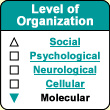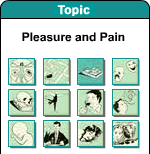| |

 |
 |
 |
Nearly 15% of all men and 30% of all women admit
to a craving for chocolate.
Over 300 substances have
been identified in chocolate. Some of these, including caffeine and theobromine
(another, less powerful stimulant) could actually cause dependency effects. But
the amounts of these substances in chocolate are too small to really have any
effect.
The same goes for phenylethylamine, a substance related to a
family of stimulants called amphetamines. For example, chocolate contains less
phenylethylamine than goat cheese.
Anandamide, a neurotransmitter produced
naturally by the brain, has also been isolated in chocolate. The neural receptors
for anandamide are the same ones to which THC, the main active ingredient in cannabis,
binds. The anandamide in chocolate might therefore contribute to the feeling of
well-being reported by “chocoholics” (though you would have to eat
well over 30 kilos of chocolate to experience effects comparable to one dose of
cannabis!).
Be that as it may, many scientists agree that dependency
on chocolate could simply be due to its taste, which causes a sensation of intense
pleasure that people want to repeat. | | |
| HOW DRUGS AFFECT NEUROTRANSMITTERS | | Dopamine
appeared very early in the course of evolution and is involved in many functions
that are essential for survival of the organism, such as motricity, attentiveness,
motivation, learning,
and memorization. But most of all, dopamine is a key element in identifying
natural rewards for the organism. These natural stimuli such as food and water
cause individuals to engage in approach
behaviours. Dopamine is also involved in unconscious memorization of signs
associated with these rewards.
It has now been established that all
substances that trigger dependencies in human beings increase the release of a
neuromediator, dopamine, in a specific area of the brain: the
nucleus accumbens.  But
not all drugs increase dopamine levels in the brain in the same way.
- Some substances imitate natural neuromediators
and take their place on their receptors. Morphine, for example, binds to the receptors
for endorphin (a natural "morphine" produced by the brain), while nicotine
binds to the receptors for acetylcholine.
- Other
substances increase the secretion of natural neuromediators.
Cocaine, for example, mainly increases the amount of dopamine in the synapses,
while ecstasy mainly increases the amount of serotonin.
-
Still other substances block a natural neuromediator. Alcohol,
for example, blocks the NMDA receptors.
Click
on the names of each of the following drugs to read about how they work and what
effects they have. Alcohol
----- Opiates
(heroin, morphine, etc.) ----- Cocaïne
----- Nicotine
Caffeine
----- Amphetamines
----- Cannabis
----- Ecstasy
----- Benzodiazepines
Cocaine Cocaine
acts by blocking the reuptake of certain neurotransmitters such as dopamine, norepinephrine,
and serotonin. By binding to the transporters that normally remove the excess
of these neurotransmitters from the synaptic gap, cocaine prevents them from being
reabsorbed by the neurons that released them and thus increases their concentration
in the synapses (see animation). As a result, the natural effect of dopamine on
the post-synaptic neurons is amplified. The group of neurons thus modified produces
much more dependency (from dopamine), feelings of confidence (from serotonin),
and energy (from norepinephrine) typically experienced by people who take cocaine.
In addition, because the norepinephrine neurons in the locus coeruleus
project their axons into all the main structures of the forebrain, the powerful
overall effect of cocaine can be readily understood.
In chronic cocaine
consumers, the brain comes to rely on this exogenous drug to maintain the high
degree of pleasure associated with the artificially elevated levels of some neurotransmitters
in its reward circuits. The postsynaptic membrane can even adapt so much to these
high dopamine levels that it actually manufactures new receptors. The resulting
increased sensitivity produces depression and cravings if cocaine consumption
ceases and dopamine levels return to normal.
Dependency on cocaine is
thus closely related to its effect on the neurons of the reward circuit. General
links about cocaine: | | |
| |




